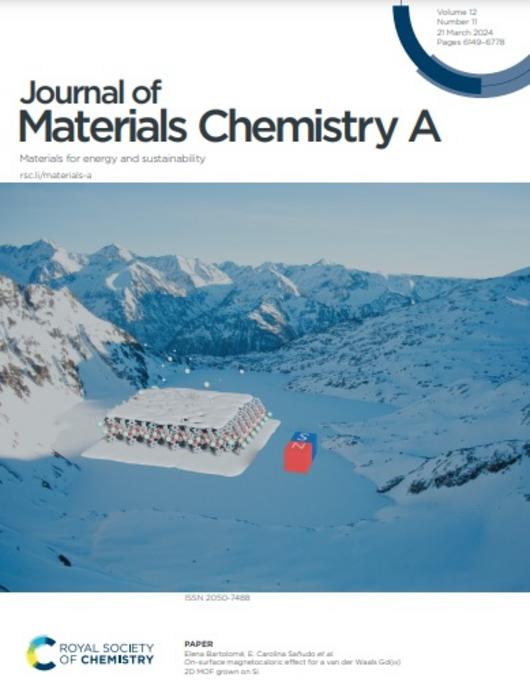The new issue of the Journal of Materials Chemistry A dedicates its cover to a new molecular compound designed by a team led by the Laboratory of Molecular Nanoscience of the Faculty of Chemistry at the University of Barcelona. The compound is based on gadolinium (Gd) — a chemical element that can generate a magnetocaloric effect — and is of particular interest in the field of molecular magnetism and in the design of devices with technological applications at the nanoscale.

Credit: Journal of Materials Chemistry A
The new issue of the Journal of Materials Chemistry A dedicates its cover to a new molecular compound designed by a team led by the Laboratory of Molecular Nanoscience of the Faculty of Chemistry at the University of Barcelona. The compound is based on gadolinium (Gd) — a chemical element that can generate a magnetocaloric effect — and is of particular interest in the field of molecular magnetism and in the design of devices with technological applications at the nanoscale.
The paper is led by Professor Carolina Sañudo, from the UB’s Faculty of Chemistry and the Institute of Nanoscience and Nanotechnology (IN2UB), and it includes much of the research carried out by Subodh Kumar, a student of the UB’s master’s degree in Nanosciences, and PdH student Guillem Gabarró, both co-authors of the paper.
The study, in which the researcher Elena Bartolomé (Institute of Materials Sciences, ICMAC-CSIC) has contributed, involves teams from the UB’s Institute of Theoretical and Computational Chemistry (IQTCUB), the Institute of Nanoscience and Materials of Aragon (INMA/CSIC/UNIZAR), the National High Magnetic Field Laboratory (United States) and the University of Oxford (United Kingdom).
Magnetic refrigerants at the nanoscale
Two-dimensional (2D) materials are compounds that provide exceptional performance for designing heterostructures — the joining of different materials with different properties — or for multifunctional devices. Specifically, the new compound is based on gadolinium (Gd), a rare earth chemical element that has seven unpaired electrons and can act as a magnetic refrigerant.
In the study, the team of the UB’s Laboratory of Molecular Nanoscience has prepared a 2D(III) composite. This compound is presented in the shape of a massive lattice-type material of metal cations and organic ligands (metal-organic framework, MOF). A particularity of Gd(III) compounds is that they are active at extremely low temperatures.
“This MOF is special because it is two-dimensional. The 2D MOFs are metal-organic equivalents to graphene and, like this compound, can be exfoliated in monolayers or in aggregates of a few monolayers at the nanometer scale”, says Carolina Sañudo, professor at the UB’s Department of Inorganic and Organic Chemistry.
In this compound, each Gd(III) ion behaves as if it were a single molecule magnet (SMM). As it is a 2D lattice compound, each monolayer is an ordered lattice of SMMs. In addition, it has a high magnetic entropy and a magnetocaloric effect (MCE) due to the fact that it contains Gd(III).
“The study of these multifunctional magnetic materials involves a multidisciplinary task where the characterization of the materials by various techniques, such as dc/ac magnetometry, calorimetry, luminescence and X-ray magnetic circular dichroism, is crucial”, notes Elena Bartolomé, researcher at ICMAB-CSIC.
In the paper, the team has succeeded in growing nanocrystals of the compound on a semiconducting silicon surface, a decisive step toward being able to use molecular materials in devices for technological applications.
The findings of the new study indicate that it is possible to use gadolinium compounds for magnetic cooling in devices. “Not only have we been able to nanostructure the material on a semiconductor, but we have shown that the magnetocaloric effect is maintained at the nanoscale, and the new compound can function as a magnetic surface coolant”, says researcher Carolina Sañudo.
Two-dimensional lattice materials — or 2D MOFs — can have potential applications depending on the metal with which they are formed. In the case of the new composite, both properties are fulfilled: as a magnet molecule (SMM) and the magnetocaloric effect (MCE). SMMs are magnet molecules that can be applied as alternatives to the miniaturization of information storage, where each Gd(III) molecule or ion acts as a bit. Having the SMMs perfectly ordered in 2D presents many advantages that the research group wants to exploit in future lines of research. In the field of magnetic refrigeration, the nanocrystals deposited on the semiconductor can be used as surface coolants at cryogenic temperatures, a property of interest to lower the temperature inside electronic circuits or devices.
Since 2020, the UB Molecular Nanoscience Laboratory has been working with compounds based on rare earth elements, such as dysprosium (Dy), terbium (Tb) and europium (Eu). “Dysprosium or terbium compounds are 2D lattice materials of magnet molecules. With terbium, europium or mixtures of terbium and europium we can also obtain highly luminescent materials that can be used as security inks”, concludes the UB researcher.
Journal
Journal of Materials Chemistry A
DOI
10.1039/d3ta06648g
Method of Research
Experimental study
Subject of Research
Not applicable
Article Title
“On-surface magnetocaloric effect for a van derWaals Gd(III) 2D MOF grown on Si
Article Publication Date
20-Feb-2024




